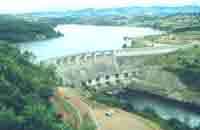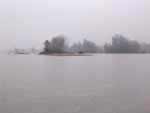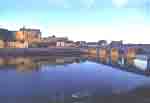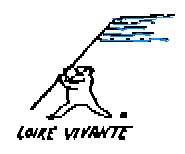the network of citizens and NGOs who is fighting for a living Loire River |
|
1971 - An official report published by the Loire-Brittany Water Agency--which oversees the whole Loire basin--mentions four projects: Naussac and Le Veurdre on the Allier river, Villerest on the Loire river and Chambonchard on the Cher river (the Allier and Cher rivers are tributaries of the Loire). A couple of other possible dam locations, including Serre de la Fare, on the headwaters of the Loire are mentioned.
1980 - September 21: the upper Loire floods the town of Brives-Charensac, a suburb of Le Puy-en-Velay ("département" of Haute-Loire): 8 people die, major damages.
1981 - The Naussac reservoir, located on a small tributary of the upper Allier river, is finished building.
1982 - Two years after the Brives-Charensac flood, the local authorities of Haute-Loire decide to support the Serre de la Fare dam project, as the sole means to guarantee the safety of the population against floods.
1983 - The Villerest reservoir, on the middle Loire is finished building.
- November: The EPALA (public office for the management of the Loire and its tributaries), headed by Jean Royer, mayor of Tours, is created.
1986 - February 13: The government, the Water Agency and the EPALA agree on a program aimed at sustaining low summer flows and preventing floods. It comprises 4 dams: Serre de la Fare on the upper Loire river, Naussac II and Le Veurdre on the Allier river and Chambonchard on the Cher river.
- June 14: Loire Vivante is created to protect the Loire from the projects promoted by the EPALA. Loire Vivante is a network of several associations, located along the Loire river, which work in an independent but coordinated way. It is supported by the World Wide Fund for Nature (WWF) and France Nature Environnement (FNE).
1988 - February: the SOS Loire Vivante Committee is created in Le Puy to oppose the Serre de la Fare dam project. The Serre de la Fare dam is meant for controlling floods, sustaining low summer flows and developing touristic activities. It is planned to be 75 meter-high and to drown 10 miles of gorges (587 hectares).
- March 1st-April 15: public inquiry concerning the Serre de la Fare project. About 4000 depositions contest the project. The inquiry commission gives its approval to the project but requires that 6 supplementary studies be led.
- March: Loire Vivante addresses a letter to President François Mitterrand, asking that the dams' construction be postponed for 3 years, in order to launch a global impact study about their effects.- September 13: First meeting between a Loire Vivante delegation and Environment Secretary Brice Lalonde.
- October: First demonstration against Serre de la Fare in Le Puy ("la Manif' des Poissons"). A thousand people demonstrate, brandishing colorful cardboard fishes, which will become the trademark of the movement.
- October 15: Prince Philip, president of WWF International, on a visit on the Loire, launches an appeal for a wild Loire: "Long life to a wild Loire !"
1989 - January 21: Requested by Brice Lalonde, a meeting between representatives of the state, the EPALA and Loire Vivante is organized.
- February 9: Brice Lalonde authorizes the construction of the Serre de la Fare dam, stating there are no more obstacles to its state-approval.
- February 11: the Serre de la Fare dam project is state-approved. ("déclaré d'utilité publique"). In France, the "Déclaration d'Utilité Publique" follows the studies on the impact, cost and other factors of a project. It is signed by the "préfet", the representative of the state in the "département".
- February 20: Demonstrators stop the first trucks on the Serre de la Fare dam site and begin occupying the site with the help of the WWF and Robin des Bois, the French branch of Robin Wood.
- February: a poll, led by high school students headed by their economics teacher (following strict polling rules and based on a sample of 14% of Brives-Charensac's inhabitants), reveals that a majority of people living in Brives-Charensac think that SOS Loire Vivante's criticisms about the Serre de la Fare dam project are more convincing than the EPALA's arguments. Most people also think there is a lack of information about means to control floods.
- March 22: the environmentalists' list, led by three members of SOS Loire Vivante, achieves 22 percent of the poll at the municipal elections in Le Puy, an unprecedented result in a traditionnally right-wing town.
- April 10: SOS Loire Vivante files a lawsuit against the Serre de la Fare dam project state-approval.
- April 28: On the day before the European demonstration in Le Puy, Brice Lalonde postpones the project, asking Loire Vivante a study, financed by the Environment Ministry, "demonstrating that an alternative solution to Serre de la Fare is technically and financially possible". Loire Vivante asks the researchers of the GRRM, "Groupe de Recherche sur les Risques Majeurs"(Research Group on Major Risks) to study the 1980 flood in Brives-Charensac and the attitude toward the risk of floods.
- April 29-30, May 1st: European demonstration in Le Puy: 10 000 people, coming from all over France and Europe, demonstrate against the Serre de la Fare dam project.
- June: the SOS Loire Vivante Committee becomes a full-fledged association, supported by WWF and FNE.- August 19-September 2: "The Water March". Members of Loire Vivante travel along the Loire, from its source to the estuary, to raise public awareness on the issue of water pollution and overuse. Water from the river, taken at each stage, is compared to the source's clear water, showing eutrophication of the existing reservoirs as well as pollution.
- October 14: the Loire Cabin ("Cabane de la Loire") is inaugurated on the occupied Serre de la Fare dam site.
- November: first advertising campaign launched by SOS Loire Vivante. The Loire: "Save me before it's too late !"
- December 9: SOS Loire Vivante, with the help of local fishing and environmentalists' associations, organizes an action to clean the banks of the Loire near Le Puy, to show the importance of an ecological maintenance of the river banks.
Back to the Campaign Summary
back to the RiverNet Homepage
These pages and their contents are © Copyright 1996 of the European Rivers Network.





